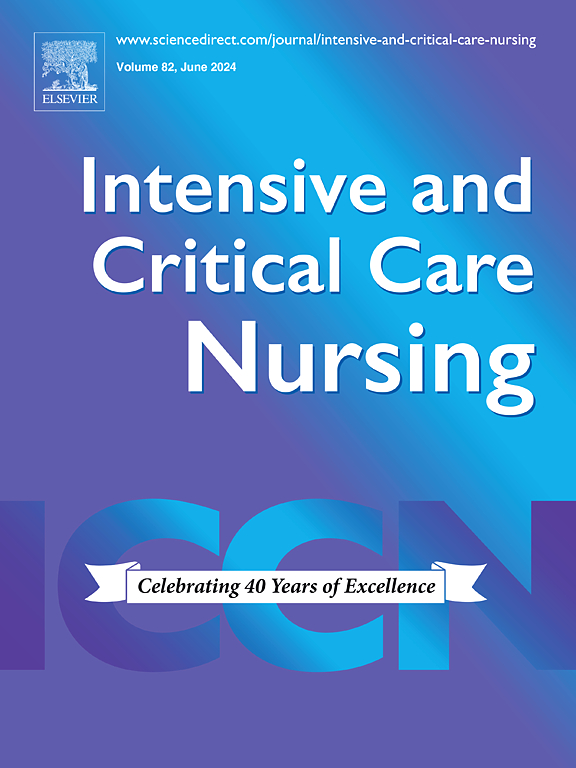Validity and reliability of the Endotracheal Suction Assessment Tool© in adult ICU patients: A methodological study
IF 4.7
2区 医学
Q1 NURSING
引用次数: 0
Abstract
Background
Novice nurses often find endotracheal suctioning signs unfamiliar. The Endotracheal Suction Assessment Tool© (ESAT©) aids pediatric nurses in suctioning but lacks an adult equivalent. A valid and reliable ESAT© for assessing intensive care unit patients’ suction needs across different populations is necessary.
Aim
To test the validity and reliability of the ESAT© in adult ICU patients.
Methods
This methodological study assessed suction needs in patients at a tertiary adult ICU of a university hospital. Two independent observers used the ESAT© to determine suction needs. Data from 106 suction procedures were collected using a patient characteristics form, the ESAT©, and a suction monitoring form. The ESAT© includes eight respiratory and ventilation parameters and seven clinical consideration parameters. Hemodynamic and respiratory parameters were measured before, and one and five minutes after suction. Linguistic validity, content validity, and pilot testing were conducted. Interobserver agreement was evaluated, and psychometric evaluation was done using content validity index (CVI) and intraclass correlation coefficient (ICC). Data were analyzed with paired samples t-test and ANOVA.
Results
Item CVI ranged from 0.80 to 1.00, and scale CVI was 0.96. Inter-item correlation and ICC for inter-rater reliability were both 0.933 (95 % CI = 0.903–0.954, p < 0.001 for ICC). Cohen’s Kappa coefficients ranged from 0.690 to 1.000 (p < 0.001), indicating high consistency between raters for all tool items. All scale items showed near-perfect agreement except SpO2, which showed substantial agreement.
Conclusion
The S-CVI was good, indicating near-perfect agreement among raters. ESAT© is highly reliable and valid for determining suction needs in adult intensive care patients.
Implications for Practice
The ESAT© aids autonomous decision-making for suctioning needs. Originally for novice pediatric nurses, the ESAT© was adapted for adult intensive care nurses. The ESAT© is valid and reliable for adult intensive care patients.
成人重症监护病房患者气管内吸入评估工具©的有效性和可靠性:方法学研究。
背景:新手护士往往对气管内吸引的体征感到陌生。气管内吸引评估工具©(ESAT©)可帮助儿科护士进行吸引,但缺乏与之对应的成人工具。目的:测试 ESAT©在成人 ICU 患者中的有效性和可靠性:这项方法学研究评估了一家大学医院三级成人重症监护病房患者的吸痰需求。两名独立观察员使用 ESAT© 确定吸痰需求。研究人员使用患者特征表、ESAT© 和吸痰监测表收集了 106 例吸痰过程的数据。ESAT© 包括八个呼吸和通气参数以及七个临床考虑参数。在吸痰前、吸痰后 1 分钟和 5 分钟测量血液动力学和呼吸参数。进行了语言有效性、内容有效性和试点测试。对观察者之间的一致性进行了评估,并使用内容效度指数(CVI)和类内相关系数(ICC)进行了心理测量学评估。数据采用配对样本 t 检验和方差分析:项目 CVI 为 0.80 至 1.00,量表 CVI 为 0.96。项目间相关性和评分者间可靠性的 ICC 均为 0.933(95 % CI = 0.903-0.954,p 结论:S-CVI 良好,表明评分者间可靠性的 ICC 为 0.933(95 % CI = 0.903-0.954,p 结论):S-CVI 结果良好,表明评分者之间的一致性接近完美。ESAT© 在确定成人重症监护患者的吸痰需求方面具有高度可靠性和有效性:ESAT©有助于自主决定吸痰需求。ESAT© 最初是为儿科新手护士设计的,后被成人重症监护护士所采用。ESAT© 对成人重症监护患者有效且可靠。
本文章由计算机程序翻译,如有差异,请以英文原文为准。
求助全文
约1分钟内获得全文
求助全文
来源期刊

Intensive and Critical Care Nursing
NURSING-
CiteScore
6.30
自引率
15.10%
发文量
144
审稿时长
57 days
期刊介绍:
The aims of Intensive and Critical Care Nursing are to promote excellence of care of critically ill patients by specialist nurses and their professional colleagues; to provide an international and interdisciplinary forum for the publication, dissemination and exchange of research findings, experience and ideas; to develop and enhance the knowledge, skills, attitudes and creative thinking essential to good critical care nursing practice. The journal publishes reviews, updates and feature articles in addition to original papers and significant preliminary communications. Articles may deal with any part of practice including relevant clinical, research, educational, psychological and technological aspects.
 求助内容:
求助内容: 应助结果提醒方式:
应助结果提醒方式:


